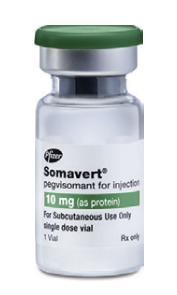Somavert Disease Interactions
There are 2 disease interactions with Somavert (pegvisomant).
Pegvisomant (applies to Somavert) diabetes
Moderate Potential Hazard, Moderate plausibility. Applicable conditions: Diabetes Mellitus
Pegvisomant is an analog of human growth hormone (GH) that selectively binds to growth hormone (GH) receptors on cell surfaces, where it blocks the binding of endogenous GH, and thus interferes with GH signal transduction. The use of growth hormones opposes the effects of insulin on carbohydrate metabolism by decreasing insulin sensitivity; therefore, glucose intolerance may improve in some patients treated with pegvisomant. Diabetic patients should be monitored closely, and the doses of anti-diabetic drugs may be reduced as necessary to avoid hypoglycemia. Blood glucose levels should be evaluated as appropriate.
Pegvisomant (applies to Somavert) liver dysfunction
Moderate Potential Hazard, Moderate plausibility. Applicable conditions: Liver Disease
Asymptomatic, transient elevations in transaminases up to 15 times ULN have been observed in patients treated with pegvisomant. Baseline serum alanine aminotransferase (ALT), aspartate aminotransferase (AST), serum total bilirubin (TBIL), and alkaline phosphatase (ALP) levels should be obtained prior to initiating therapy with pegvisomant. Care should be exercised when using this agent in patients with liver dysfunction and its use should be used in accordance with the information presented in the manufacturer prescribing information with respect to liver test abnormalities.
Switch to professional interaction data
Somavert drug interactions
There are 74 drug interactions with Somavert (pegvisomant).
More about Somavert (pegvisomant)
- Somavert consumer information
- Check interactions
- Compare alternatives
- Pricing & coupons
- Reviews (4)
- Drug images
- Side effects
- Dosage information
- During pregnancy
- Drug class: growth hormone receptor blockers
- Breastfeeding
- En español
Related treatment guides
Drug Interaction Classification
| Highly clinically significant. Avoid combinations; the risk of the interaction outweighs the benefit. | |
| Moderately clinically significant. Usually avoid combinations; use it only under special circumstances. | |
| Minimally clinically significant. Minimize risk; assess risk and consider an alternative drug, take steps to circumvent the interaction risk and/or institute a monitoring plan. | |
| No interaction information available. |
See also:
Further information
Always consult your healthcare provider to ensure the information displayed on this page applies to your personal circumstances.


